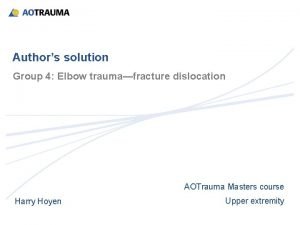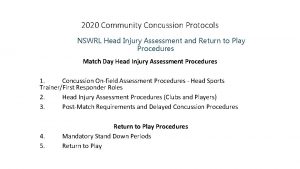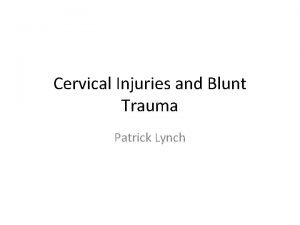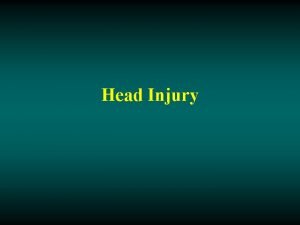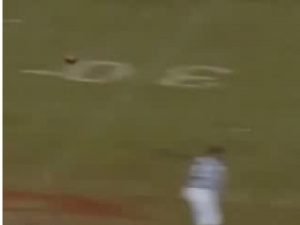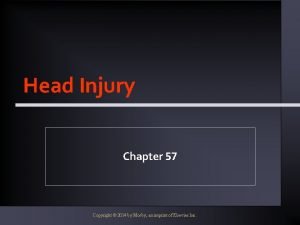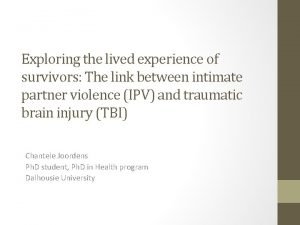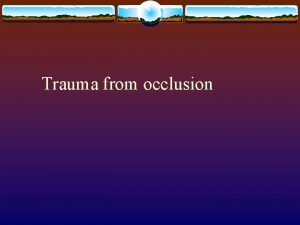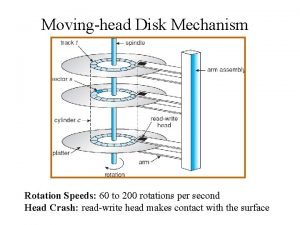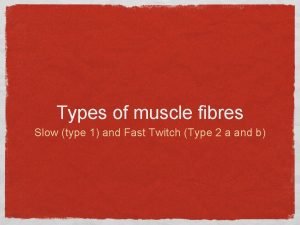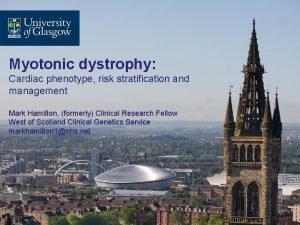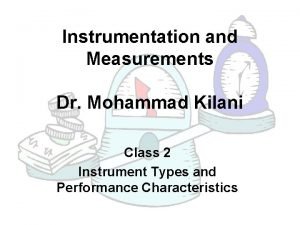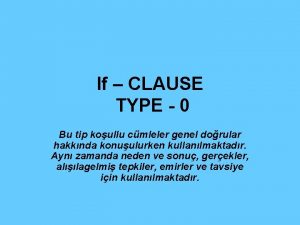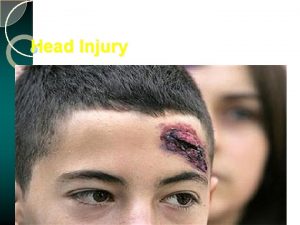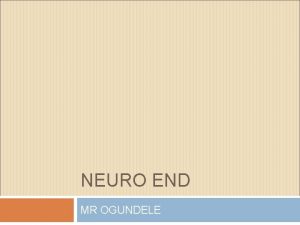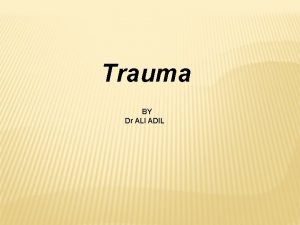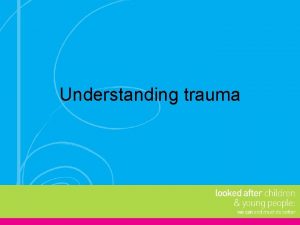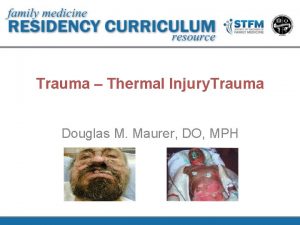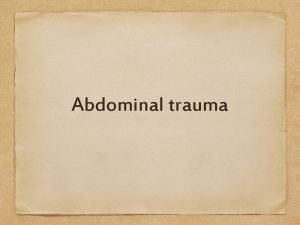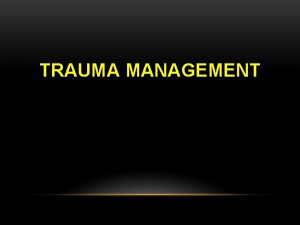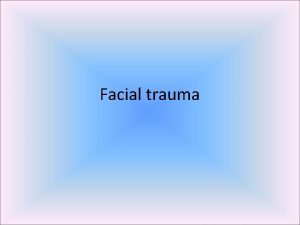Head injury Trauma is a type of injury
































- Slides: 32

Head injury • Trauma is a type of injury which effects the body by external force being applied in a violent and sudden manner. When dealing with motorcycle accidents, it's important to understand the types of forces which a rider is subjected to, the body parts affected by these forces.

Head injury • First, let's define the different types of trauma. 1. Penetrating trauma 2. Blunt trauma 3. Acceleration/deceleration trauma

Head injury • Penetrating trauma is an object entering the body or head due to an object striking the body, or the body being placed in motion and striking an object which then penetrates the body. Blunt trauma occurs when an object strikes the body or head with force causing a compression of body tissues which results in injury.

Head injury • Acceleration/deceleration trauma occurs when the body is moving and strikes another moving or stationary object. This results in • a change of motion for the body, or • a complete stop of motion, which causes stretching and tearing of body tissues • preťahovanie a trhanie telesných tkanív




Head injury • Concussion of brain – commotio cerebri • Compression of brain – subdural, epidural haematoma • Contussion of brain – intracerebral contussion with bleeding

Commotio cerebri • • • Reversible damage Generalised asynapsia Amnesia – retro or anterograde Unconsciousness +- short duration Desorientation Vomitus, headache

Commotio cerebri • Take care about patient !!! • Free interval after head injury • Development of subdural or epidural haematoma

• Bleeding from veins • Slower development than in epidural haematoma

Signs of subdural and epidural haematoma • • Anizokoria Bradykardia Hemiparesis Focal signs

Subdural haematoma

Brain CT Subdural haematoma Epidural haematoma

Isodense subdural haematoma • There is some midline shift to the left • The grey matter is apparently increased in thickness on the right due to the adjacent isodense blood • The sulcal pattern is effaced on the right • Where sulci are visible, they are displaced medially from the cranial vault by the thickness of the haematoma.

Epidural haematoma

Epidural haematoma • Bleeding from arteries • Quicker development • Bone fracture – often • Plane X-ray of the skull

Subdural, Epidural haematoma • Therapy • Epidural - emergency operation • Subdural - emergency operation or, in the small hematoma we can onitor the patient • After some time – chronic subdural hematoma

Traumatic intracerebral haemorrhage


Severe closed head injury • A) Noncontrasted axial computed tomography (CT) scan • (B) a fluid-attenuated inversion recovery (FLAIR) magnetic resonance (MR, right) image of a 10 -year-old boy 48 hours after he sustained a severe closed head injury. • The region of hyperintense signal in the brain stem visible on the MR image cannot be detected on the CT scan.

Consequences of head injury • • Posttraumatic parkinsonism Posttraumatic epilepsy Apalic syndrom Brain death

Apalic syndrom • Signs of damage of brain cortex (pallium) with not damaged brainstem • Brainstem reflexes are preserved, including spontaneous breathing and heart function • Patient is not able to be in verbal or visual contact with other people • Muscle hypertonia

Apalic syndrom • Patient is fed by nasogastric tube or by gastrostomia • Positive axial reflexes – grip, saccing reflexes • Patient is incontinent

Spinal cord injury • A severe spinal cord injury often causes loss of feeling and paralysis • the loss of movement and voluntary control over the muscles in the body. • Spinal cord damage also causes loss of reflex function below the point of injury interrupting bodily functions such as breathing, bowel control, and bladder control. • In the event of a spinal injury prompt medical attention can help to minimize further spinal cord damage.

Spinal cord injury



Spinal cord injury



Spinal cord injury – first aid
 Intentional injury and unintentional injury
Intentional injury and unintentional injury Emt chapter 24 trauma overview
Emt chapter 24 trauma overview Head trauma classification
Head trauma classification Nrl head injury recognition and referral form
Nrl head injury recognition and referral form Patrick lynch head injury colorado
Patrick lynch head injury colorado Battle's sign
Battle's sign Cholesteatoma
Cholesteatoma Copyright
Copyright Head injury assessment
Head injury assessment Glickman's concept
Glickman's concept Indexing head parts
Indexing head parts The attacking firm goes head-to-head with its competitor.
The attacking firm goes head-to-head with its competitor. Html tagi
Html tagi Operation of moving head disk storage
Operation of moving head disk storage Neck part of body
Neck part of body What is a tonic syllable
What is a tonic syllable Pro minent
Pro minent Condyles of femur
Condyles of femur Pre-head head tonic syllable tail
Pre-head head tonic syllable tail The head of moving head disk with 100 tracks
The head of moving head disk with 100 tracks Floating head heat exchanger hydrotest
Floating head heat exchanger hydrotest I laugh my head off
I laugh my head off Is hyper v type 1 or type 2
Is hyper v type 1 or type 2 What is the primary function of wave summation
What is the primary function of wave summation Type of errors in statistics
Type of errors in statistics Type 1 error vs type 2 error example
Type 1 error vs type 2 error example Rock cycle sedimentary
Rock cycle sedimentary Narrow band theory in sport
Narrow band theory in sport Sublimation psychology
Sublimation psychology Myotonic dystrophy
Myotonic dystrophy Deflection type instruments
Deflection type instruments ıf clauses type 0
ıf clauses type 0 Hypothesis definition
Hypothesis definition


